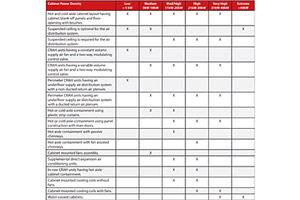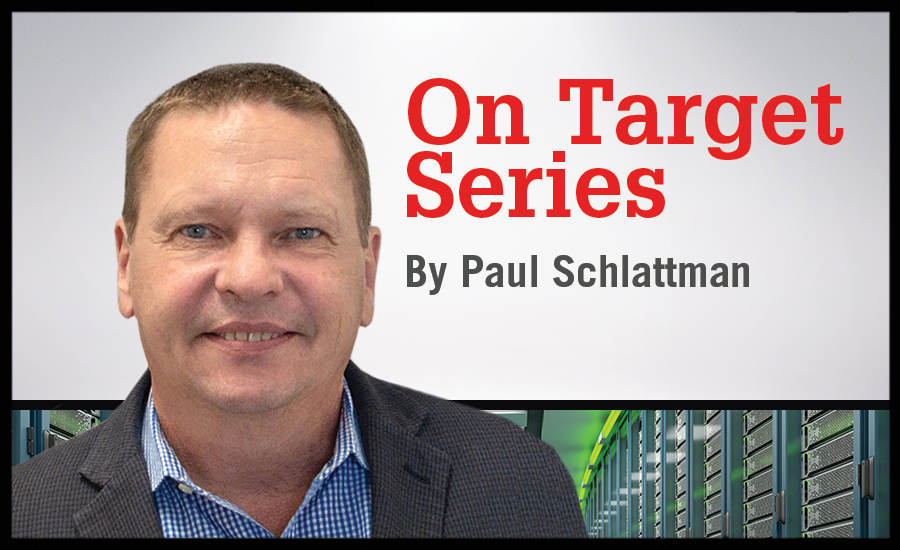PLANNING FOR THE GREENFIELD SITE

|
|
Table 1. Different cooling methods using floor heights, containment, and other design features. |
Earlier in the series we discussed identifying power, fiber, and threat. As we progress to the final selection, it is important to consider regional construction methods for building a greenfield data center as well as wholesale/colocation providers design criteria for comparison. Each geographical region offers its own advantages and disadvantages. Some of the regional items that need to be considered include:
• Building materials. For example, concrete is often used within the Texas region because of its abundance, whereas on the East Coast steel structures are the preferred option.
• PUE and weather. Selecting the best mechanical system to reduce PUE is based upon humidity, year-round temperature ratings, and altitude. Regions such as the San Jose area allow for 98% free cooling via an airside economizer, whereas the Chicago area requires chilled water running in series with a heat exchanger due to the humidity. The system heat rejection is accomplished through cross-flow open cell cooling towers and the centrifugal chillers are arranged in a series waterside economizer configuration with plate-and-frame heat exchangers. Each region within the country offers a unique approach to PUE reduction.
• Labor costs and unions. Urban areas have a higher cost of labor for construction than most rural regions. Variances in labor cost can differ by 3% to 18% for the total workforce.
One of the most important factors in selecting a greenfield site is to purchase plenty of land for expansion. In too many cases, a company will purchase the exact requirement for their day one build of the new data center. However, land is probably the least expensive item in the entire project, specifically if the project is in a rural area. Additionally, land buffers offer a higher level of security if the data center can be set back from the property line.
An important design feature of a new greenfield data center is the “onion principal.” This design technique locates the data center in the middle of the building, protecting it from exterior elements. Future expansion in this design typically requires a linear concept, growing the data center furthest away from the front property line.
WHOLESALE/COLOCATION PLANNING
Within Part One of this series we discussed developing a prototype design that lays out day one equipment racks and future expansion. This prototype becomes the basis of the floor plan within the new wholesale/colocation floor plate. Some of the key items to address during the site selection of the wholesale/colocation providers include:
• Concurrently maintainable. As previously discussed in Part One, it is crucial to ensure that the provider has the capability to conduct maintenance without disruption to online processing. This is typically done through redundancy at multiple levels. The key question in evaluating concurrent maintenance is, Do the servers require clean power at all times during maintenance? The answer to this question alone can create millions of dollars in UPS and switchgear costs to support clean power.
• Methods of operations (MOPs). During the evaluation of a wholesale/colocation provider it is important to investigate several factors such as security, full time staff, monitoring techniques/reporting, and service-level agreements.
• Shared infrastructure vs. dedicated infrastructure. Each provider seems to be different in their operating models. In many cases a wholesale company will provide 10,000 to 12,000 sq ft supported by a 2N, 1MW to 1.5MW critical load. The wholesale provider may charge for the entire critical load based upon a kw price. In other cases, they may split the load and square footage to accommodate multiple tenants. Colocation providers, however, may charge by the rack cabinet or cage and share infrastructure with other tenants. In this scenario, the tenant must always be able to monitor the UPS load to ensure that it does not exceed its ratings.
MECHANICAL RAISED ACCESS FLOOR SYSTEM SUPPORT
Recently, we did a comparison of the different heights of raised floors and determined what heights support watts per sq ft. Table 1 identifies different cooling methods using floor heights, containment, and other design features.
PROJECT SCHEDULING
Due to the growth within applications and processing, “speed-to-market” has become critical when building out a new data center. Greenfield design and construction (in an aggressive mode) can be typically built out within nine to 12 months. Wholesale and colocation providers offer prebuilt white space which is primarily ready for day one equipment. This is perhaps the most beneficial feature of the wholesale provider for the enterprise tenant.
CONSTRUCTION COST MODELING
In general, cost per sq ft or kw should not be the criteria when estimating the construction cost of a new data center. There is no general rule of thumb concerning shell and core construction, nor mechanical system costs due to variables in materials. Estimating should be on a project by project basis with line item CSI costs used to create the final budget.




